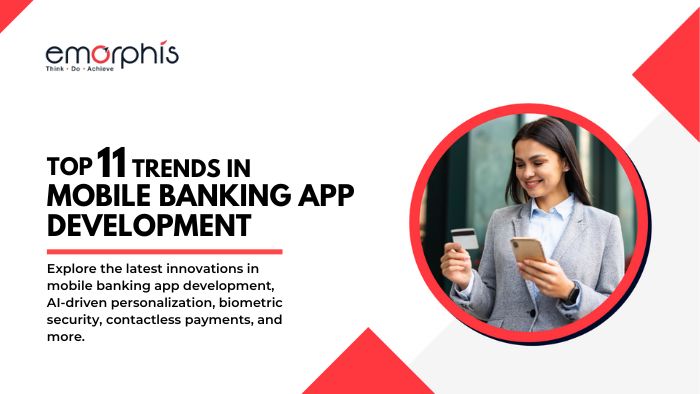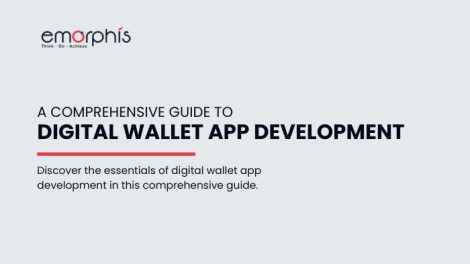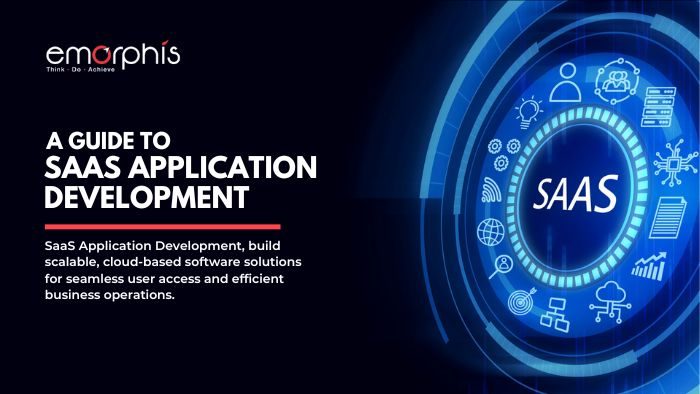Introduction
In the ever-evolving landscape of technology, the banking sector has witnessed a significant transformation with the advent of mobile banking apps. Moreover, with mobile banking app development, these apps have revolutionized the way people manage their finances, offering convenience, accessibility, and security right at their fingertips.
According to the Statista report, we can expect a continuous and steady increase in the number of digital banking users in the United States as we progress from 2021 through 2025. Initially, there were approximately 197 million users in March 2021, and based on forecasts, this figure is poised to reach an impressive nearly 217 million by the year 2025. This upward trajectory reflects the growing popularity and adoption of digital banking services among the U.S. population, underscoring the sector's expanding influence and significance in modern finance.
However, as mobile usage for digital banking continues to surge, mobile banking app development has become a dynamic field, characterized by constant innovation and adaptation.
Let us check with details of the upgrade you need.

Why Do You Need To Upgrade Your Mobile Banking App With The Latest Trends?
Upgrading your mobile banking app with the latest trends is essential for staying competitive and also meeting the evolving needs and expectations of your users. Here are the reasons in bullet points:
a. Enhanced User Experience
- Incorporating the latest trends ensures that your app offers a modern, user-friendly interface.
- Personalized experiences and AI-powered insights lead to higher user engagement and satisfaction.
b. Competitive Edge
- Following trends sets you apart from competitors and shows your commitment to innovation.
- Users are more likely to choose an app that aligns with current industry standards.
c. Security and Trust
- Upgrading security measures like biometric authentication and blockchain also enhance user trust.
- Keeping up with security trends moreover protects user data from emerging threats.
d. Seamless Integration
- Integrating fintech services like digital wallets and robo-advisors provides comprehensive solutions.
- Users also appreciate having multiple financial services within a single app.
e. Adapting to User Behavior
- Trends like voice banking and AR cater to changing user preferences and behaviors.
- User-centric features keep your app relevant and user-friendly.
f. Leveraging Emerging Technologies
- Embracing 5G and AR offers improved app performance and immersive experiences.
- Staying ahead of technological advancements keeps your app future-proof.
g. Educational Value
- Gamification and AI-powered insights promote financial literacy.
- Educated users make better financial decisions, leading to long-term loyalty.
h. Social Responsibility and Brand Image
- Reflecting environmental and social responsibility attracts socially conscious users.
- Apps with a positive impact build a strong brand image and user trust.
i. Open Banking Opportunities
- Integrating open banking and forming fintech partnerships expands service offerings.
- Open banking provides users with a holistic financial experience.
j. Customer Retention and Loyalty
- Upgrading with trends keeps users engaged and less likely to switch to competitors.
- A loyal user base leads to sustained growth and positive word-of-mouth.
k. Regulatory Compliance
- Staying up-to-date with trends helps you adapt to evolving regulatory requirements.
- Compliance builds user trust and avoids legal complications.
In this article, we will delve into the top trends shaping the future of mobile banking app development, exploring how these trends are reshaping user experiences, security protocols, and overall industry dynamics.
Top Trends Shaping The Future of Mobile Banking App Development
1. The Shift to Personalized User Experiences
Gone are the days of one-size-fits-all banking solutions. The trend in mobile banking app development is firmly headed toward offering highly personalized user experiences. Moreover, banking apps are now integrating sophisticated artificial intelligence (AI) and machine learning (ML) algorithms to analyze user behavior and preferences. By doing so, these apps can tailor their offerings to meet individual needs, preferences, and financial goals.
For example, consider a user who frequently makes online purchases. A well-developed banking app could recognize this pattern and also offer personalized savings or investment plans that align with the user's spending habits. Similarly, if a user frequently travels abroad, the app could suggest travel-friendly financial products with minimal foreign transaction fees. This trend enhances user engagement and builds long-term loyalty by making the app an indispensable financial companion.
Have a look at the details on A Guide to Best Practices and Strategies for Fintech App Development
2. Seamless Integration of Fintech Services
The synergy between traditional banking services and fintech solutions has given rise to a trend of seamless integration within mobile banking apps. Fintech, short for financial technology, encompasses a wide array of services such as peer-to-peer payments, robo-advisors, digital wallets, and cryptocurrency management. Moreover, to provide users with comprehensive financial solutions, banking apps are increasingly partnering with fintech companies or developing in-house fintech capabilities.
A prime example of this trend is the integration of digital wallets and payment platforms. Mobile banking apps are incorporating features that also allow users to link their accounts to digital wallets like Apple Pay or Google Pay, enabling them to make contactless payments conveniently. Additionally, some apps offer direct access to investment platforms, enabling users to manage their portfolios without having to switch between different applications.
3. Enhanced Security Measures
As the reliance on mobile banking apps grows, so does the need for robust security measures. Users are rightfully concerned about the safety of their financial data, and developers are also responding by implementing cutting-edge security protocols. Biometric authentication methods such as fingerprint recognition and facial scanning have become commonplace, replacing traditional passwords and PINs.
Furthermore, the rise of blockchain technology is impacting mobile banking app security. Blockchain's decentralized and tamper-resistant nature can be leveraged to enhance data security and also reduce fraud. For instance, some apps are exploring the use of blockchain for secure document verification, ensuring the authenticity of important financial documents.
4. The Emergence of 5G Technology
The rollout of 5G technology is set to revolutionize mobile banking app development. With its significantly faster data speeds and lower latency, 5G opens up possibilities for enhanced app performance and more immersive user experiences. This trend is particularly relevant for features that require real-time updates and high-definition graphics, such as interactive financial dashboards and video customer support.
Imagine a user conducting a video call with a customer support representative directly from the banking app. With 5G, the call quality would be impeccable, enabling efficient issue resolution. Additionally, the app's performance would be smoother and more responsive, leading to a seamless user experience even during high-data-traffic periods.
5. Rise of Chatbots and AI-Powered Customer Support
Chatbots have become an integral part of modern mobile banking apps, transforming customer support services. Moreover, these AI-powered assistants are available 24/7, addressing user queries and concerns promptly. Also, they offer a quick and efficient way for users to get information about their accounts, transactions, and general banking inquiries.
For example, if a user notices an unusual transaction on their account, they can simply type a query into the app's chatbot. The chatbot can instantly provide information about the transaction, offer steps to resolve the issue, and also initiate the process of blocking the card if necessary. This trend not only improves customer satisfaction but also reduces the load on human customer support representatives.
Check more details on How AI Chatbots are Empowering the FinTech Industry?
6. Augmented Reality (AR) for Enhanced Banking Experiences
The integration of augmented reality (AR) technology is one of the more futuristic trends in mobile banking app development. AR superimposes digital elements onto the physical world, resulting in interactive and also immersive encounters. While this trend is still in its early stages, some banking apps are already exploring its potential.
Imagine a scenario where users can use their smartphone cameras to scan a property they're interested in purchasing. The app could then overlay information about property prices, mortgage rates, and loan eligibility, providing users with instant insights into their financial options. This level of interaction enhances user engagement and moreover, transforms the app into a valuable financial planning tool.
7. AI-Powered Financial Insights
In addition to personalized user experiences, AI is also being harnessed to provide users with proactive financial insights. Moreover, mobile banking apps are increasingly using AI algorithms to analyze users' spending patterns, bill payments, and investment behavior. Based on this analysis, the app can offer tailored financial advice and suggestions to help users save money, manage debt, and, also achieve their financial goals.
For instance, if the app notices that a user spends a significant portion of their income on dining out, it could suggest budget-friendly recipes or local deals to help them save money. Moreover, if the app detects a surplus of funds in a user's account, it might recommend moving those funds into a higher-interest savings account or investing in a diversified portfolio.
8. Voice Banking and Virtual Assistants
Voice recognition technology has made remarkable strides, and it's finding its way into mobile banking apps as well. However, the rise of voice assistants like Siri, Google Assistant, and Amazon Alexa has led to an expectation for voice-enabled interactions. Mobile banking apps are incorporating voice recognition features that allow users to perform banking transactions and inquiries through voice commands.
This innovative approach allows customers to interact with their bank accounts and financial services using spoken commands or queries, subsequently replacing traditional methods such as typing on a computer or mobile device.
Furthermore, voice banking encompasses a wide range of functionalities. This includes checking account balances, transferring funds between accounts, also paying bills, and even making investment inquiries. It achieves this by leveraging artificial intelligence and natural language processing, which in turn enables it to understand and respond accurately to users' spoken requests.
Moreover, voice banking holds the potential to enhance financial inclusivity, thereby making banking services more accessible to individuals with disabilities or those who may face challenges with traditional online banking interfaces.
To illustrate, imagine a user asking their banking app questions like, "What is my current account balance?" or "Could you please transfer $100 to my savings account?" In response, the app's virtual assistant seamlessly executes the requested tasks. This emerging trend not only elevates accessibility for individuals with disabilities but also provides a hands-free, effortless means of engaging with banking services.
9. Environmental and Social Responsibility
In an era where sustainability and social responsibility are gaining prominence, mobile banking apps are beginning to reflect these values. Users are showing an increasing interest in banking with institutions that align with their ethical and environmental beliefs. As a result, some mobile banking apps are incorporating features that highlight their commitment to sustainability and community engagement.
For instance, an app might allow users to track the environmental impact of their spending habits, such as the carbon footprint associated with travel expenses or donations made to eco-friendly initiatives. Additionally, the app could offer options to donate a portion of cashback rewards to charitable organizations. This trend not only attracts socially conscious users but also contributes to a positive brand image for the banking institution.
10. Gamification for Financial Education
Financial literacy is a crucial skill that many people lack, leading to poor financial decisions and outcomes. To address this gap, mobile banking apps are incorporating gamification elements to educate users about personal finance in an engaging and interactive manner. Gamification involves using game-like mechanics to teach users about budgeting, saving, investing, and other financial concepts.
For instance, an app could offer interactive quizzes, challenges, or simulations that teach users how different investment options work. Users could earn virtual rewards for completing educational modules, making the learning process enjoyable and incentivized. This trend not only enhances users' financial knowledge but also fosters a positive relationship between users and the app.
11. Fintech Partnerships and Open Banking
Open banking is a concept that promotes the sharing of financial data through secure APIs (Application Programming Interfaces) between different financial institutions. Moreover, this trend allows users to access a broader range of financial services from various providers through a single mobile banking app. Many banking apps are also embracing open banking and forming partnerships with fintech companies to offer users a comprehensive suite of financial products.
With Open Banking, individuals can grant authorized third-party applications or providers access to their bank account information. This, in turn, allows for a variety of benefits and services. Customers can aggregate their financial information from multiple accounts and institutions into a single dashboard or app, also making it easier to manage their finances comprehensively. Moreover, third-party providers can offer customized financial products and services based on a customer's financial data and behavior.
Open Banking fosters a fertile ground for innovation in the financial sector, encouraging the development of new fintech solutions, such as budgeting apps, investment tools, and loan comparison platforms. Open Banking frameworks emphasize stringent security standards and consent mechanisms to ensure that customer data remains protected and, also private. It's essential to note that Open Banking regulations vary by region, with different countries implementing their own frameworks and standards.
For example, a mobile banking app could collaborate with a lending fintech to provide users with instant loan approval based on their transaction history. Similarly, an app could partner with an investment fintech to enable users to diversify their portfolio by seamlessly investing in different asset classes. This trend enhances user choice and convenience by consolidating various financial services under one platform.
Find out the details of the fusion of AI and fintech app development - AI-Based Fintech App Development
Some More Trends which could not be missed
Social banking, with its inherent focus on fostering connections and collaboration, has gained prominence in recent years. In today's interconnected world, financial institutions are recognizing the need to extend their services beyond the traditional realm. Moreover, by integrating social media features, they can offer customers a seamless bridge between their financial lives and their social networks.
Furthermore, this approach allows users to effortlessly split bills, share expenses, and make peer-to-peer payments, all within the confines of their favorite social media platforms. In addition, social banking provides an avenue for financial institutions to engage with customers in a more informal and interactive manner. One more trend to note here is IoT app development and integration services. IoT sensors can provide valuable information related to spending patterns and habits, which can be leveraged for personalized financial advice and budgeting. Moreover, IoT integration enhances security by allowing for device-based authentication and monitoring of unusual or suspicious transactions.
Ecosystem expansion and scalability are key considerations in the dynamic landscape of mobile banking. Financial institutions are recognizing the importance of becoming an integral part of the broader digital ecosystem. As a result, partnerships with retail, healthcare, transportation, and other sectors are becoming more prevalent. These collaborations offer customers a more comprehensive and interconnected suite of services.
Moreover, as the customer base grows and the demand for features increases, scalability becomes paramount. Financial institutions must design their mobile banking apps with the flexibility to accommodate growth in terms of both user numbers and functionality. Scalability ensures that the app can evolve and adapt to meet the evolving needs and expectations of a growing customer base, thereby maintaining a competitive edge in the market.

What Expertise You Should Look For A Fintech App Development Company For Updating Or Mobile Banking App Development?
When seeking a fintech app development company to update or develop your mobile banking app, it's essential to choose a partner with the right expertise and capabilities to ensure a successful project. Here are key factors to look for in a fintech app development company.
Fintech Domain Knowledge
- Look for a company with a deep understanding of the fintech industry, including financial regulations, security protocols, and emerging trends.
Mobile App Development Expertise
- Ensure the company has a strong track record in mobile app development, with experience in creating secure, user-friendly, and feature-rich apps.
UI/UX Design Experience
- User interface and experience are crucial for banking apps. Choose a company with a skilled design team that can create intuitive and visually appealing interfaces.
Security Focus
- Security is paramount in fintech. The company should have a robust approach to data protection, encryption, and secure authentication methods.
Technology Stack
- Make sure the company is proficient in the latest app development technologies, languages, and frameworks relevant to mobile banking apps.
Fintech Integration
- Look for experience in integrating various fintech services, such as payment gateways, digital wallets, investment platforms, and blockchain solutions.
Data Analytics and AI
- Fintech apps benefit from data analysis and AI-driven insights. A company with expertise in AI and analytics can provide valuable features.
Regulatory Compliance
- Choose a company that is well-versed in financial regulations and compliance standards to ensure your app adheres to legal requirements.
Testing and Quality Assurance
- Quality assurance is crucial for banking apps. The company should have rigorous testing processes to identify and fix potential issues.
Scalability
- A fintech app should be able to handle increasing user demands. Ensure the company can develop scalable solutions to accommodate growth.
Fintech Partnerships
- Companies with existing partnerships or networks in the fintech industry can offer additional value through collaborations and integrations.
Case Studies and Portfolio
- Review the company's past projects and case studies to gauge their capabilities and see if they align with your app's requirements.
Client Feedback and References
- Reach out to their previous clients to gather feedback on their work, communication, and project management.
Project Management Approach
- Look for a company that follows an organized project management methodology, ensuring timely delivery and effective communication.
Communication Skills
- Effective communication is vital for a successful collaboration. Ensure the company can understand your needs and keep you informed throughout the development process.
Long-term Support
- Mobile banking apps require ongoing maintenance and updates. Opt for a company that provides services for post-launch support and maintenance.
Innovation and Creativity
- Fintech is a rapidly evolving field. Seek a company that is innovative and creative, and capable of suggesting new features and improvements.
A fintech app development company that possesses these qualities can serve as a reliable and skilled partner in updating or developing your mobile banking app. Emorphis Technologies is an example of such a company, known for its expertise in crafting innovative fintech solutions and staying abreast of industry trends.
Take a look at and article Exploring the World of Fintech Apps: Revolutionizing Finance with Innovative Solutions
Fintech App Development And Emorphis Technologies
As the trends in mobile banking app development continue to evolve, the role of fintech app development companies becomes increasingly crucial. Fintech app developers specialize in creating innovative and secure financial solutions that align with the latest industry trends. One such prominent player in the fintech app development landscape is Emorphis Technologies.
Emorphis Technologies has established itself as a leading fintech app development company, known for its expertise in crafting cutting-edge banking solutions. With a focus on user-centric design, security, and emerging technologies, Emorphis Technologies is at the forefront of shaping the future of mobile banking app experiences.
The company's portfolio boasts a range of successful projects, demonstrating its ability to create seamless, secure, and feature-rich apps that cater to the modern user's financial needs. Check the various solutions in the fintech portfolio.

Conclusion
Mobile banking app development is a dynamic field that continues to evolve in response to changing user preferences, technological advancements, and industry dynamics.
The trends discussed in this article underscore the industry's commitment to providing personalized experiences, integrating fintech solutions, enhancing security measures, and leveraging emerging technologies.
As mobile banking apps become increasingly central to people's financial lives, the role of fintech app development companies like Emorphis Technologies becomes indispensable in shaping the future of banking experiences.
Find the Top Trends in Fintech App Development in 2023-24
As we move forward, the collaboration between traditional banking institutions and fintech innovators will likely drive the development of even more innovative and user-centric mobile banking solutions.







